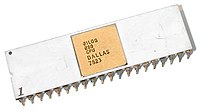
Photo from wikipedia
The utility industry is currently undergoing a substantial change from an analogue to a digital infrastructure. Not only plant performance and utility profits are dependent on accurate plant operational parameters… Click to show full abstract
The utility industry is currently undergoing a substantial change from an analogue to a digital infrastructure. Not only plant performance and utility profits are dependent on accurate plant operational parameters but, more importantly, set safety limits need to be met in order to ensure safe operation of nuclear power plants in particular. Using non-quality-assured process data for operational decisions can result in significant over- or under-power of the plant. In addition, all new technologies such as AI, IIoT, digital twin technology, etc. rely on robust process data as input, putting at risk the significance of the results from the continuing data processing ("garbage in, garbage out"). One method, certified process data reconciliation, or CPDR, cuts through the vast amount of available process data and generates all relevant process values with the smallest uncertainty possible. 95% of all collected process data can be discarded after introduction of CPDR. With CPDR, plant operation and maintenance can be significantly optimized and utilities can profit by realizing e.g. power recovery and measurement uncertainty recapture (MUR). Because the focus on reconciled instead of measured values constitutes a paradigm shift, the application of CPDR needs to be communicated to Nuclear Regulators. This paper describes the approach and experience of the Regulator acceptance process in various countries around the globe.
Journal Title: Journal of Nuclear Engineering and Radiation Science
Year Published: 2021
Link to full text (if available)
Share on Social Media: Sign Up to like & get
recommendations!